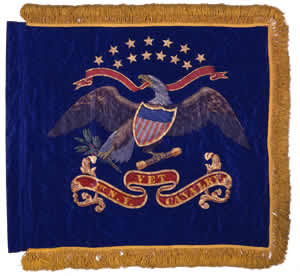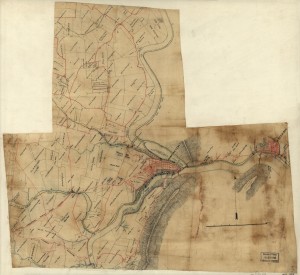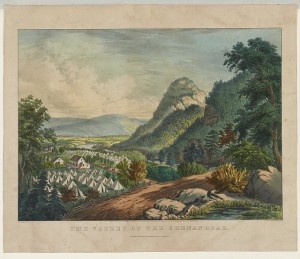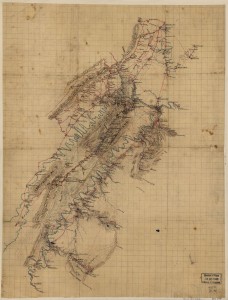For over three months the New York First Veteran Cavalry had been stationed at the cavalry depot near Washington, D.C. In early February 1864 the regiment left the capital and headed to the Harper’s Ferry area. Our SENECA correspondent wrote a letter home 150 years ago today. He had already literally ripped of a souvenir from John Brown’s jail cell in Charlestown. Later the regiment participated on a ‘scouring’ expedition in the Shenandoah Valley as far south as Strasburg. Also, rebel bushwackers/guerrillas apparently viciously killed one of SENECA’s fellow cavalrymen.
From a Seneca County, New York newspaper in 1864:
First Veteran Cavalry.
CAMP SULLIVAN, VA.,
(Near Harper’s Ferry,) Feb. 15, 1864.
FRIEND STOWELL: – The 1st. Veteran cavalry has “changed its base” but in rather a different direction from that anticipated, for instead of going to Texas, as we were led to believe we should, we were suddenly ordered to pack our saddles and march to Harper’s Ferry, and on Tuesday the 2d inst. the Regiment broke camp and left its pleasant location at Giesbow Point, for the celebrated Valley of the Shenandoah.
Passing through Rockville and Frederick City, places familiar to many of us, we arrived at Harper’s Ferry on the afternoon of the third day, and marching about four miles up the valley encamped once more upon the “sacred soil” near a place called Hall Town.
We soon found that we were indeed in the field again, for after a rest of only one day, we were in the saddle and off on a scout up the Shenandoah. Co. K, however, only went as far as the village of Charlestown, which it occupied, and with Co. C, held for three days; while the rest of the regiment scouted through the surrounding country and up the river twenty or thirty miles.
Charlestown is noted as being the place where “Old John Brown, who went to Harper’s Ferry,” was confined, tried, and executed. The Jail still stands, but having been occupied by our troops several times, presents rather a dilapidated appearance. – While we were here your correspondent succeeded after much exertion in wrenching from its iron fastenings the huge lock which fastened “Old John” in his cell, and sent it northward, a memorial of what here occurred. Just opposite the jail in the Court House, where John Brown was tried, and where at a later date the 1st Maryland Regiment were surrounded, and gallantly resisted an overwhelming force of the Rebels, the thick walls are every where perforated for loop holes from which the besieged fired their rifles until all their ammunition was exhausted, and the marks of shot and shell are visible in all directions. Our Regiment having accomplished the object for which it was sent out, returned to camp, and we evacuated Charlestown and fell back also.
But there is no rest for “Ye gallant Cavaliers,” for at three o’clock on Friday morning the bugles sounded, and long before daylight the whole Cavalry Brigade was off again, on another raid up the Shenandoah. We divided into parties of three or four hundred each, and proceeded by different routes up the valley in search of the bands of Guerrillas that infest this part of the country. Company K and three other companies, under command of major Sullivan, were ordered to scour the country as far as Strasburg, which place we reached on the evening on the same day, having made a march of about sixty miles, and dashed into the villages of Berryville, Milwood, White Post, Newton, and Middletown on the route. The roads were in a splendid condition and we enjoyed the ride vastly. The Turnpikes are all macadamized, perfectlt smooth and hard, and superior to any you can point out in the North. The roads run in all directions through Western Virginia and have been of great advantage to the Rebs, facilitating the rapid movement of their armies and the transportation of supplies. The Valley of the Shenandoah is called the Garden of Virginia, and well it may be. Well stocked farms and stately mansions, beautiful groves and smiling pastures meet the eye in all directions. The negroes were plowing as we passed, and many a field was already green with new wheat.
Arriving at Strasburg about six o’clock we dashed into the town in hopes of capturing some of Gillmore’s Band said to be there, but finding “nary Reb,” fell back, and bivouacked in the woods, and in the morning marched to Winchester having a little skirmish on the way, and a race of two hours through the woods after a squad of Guerrillas.
Winchester is quite an important town, the largest in the Valley and has been the scene of some hard fighting; but more of this at some other time, as my letter is getting rather long already. After a short rest we marched back to camp, which we reached late Saturday evening pretty well tired out, having marched about one hundred and twenty miles in two days. Since we have been here we have captured eleven Bushwackers, shot a few more and lost two men, one of whom, we found tied to a tree with his arm torn off, and a ball through his his heart. Our boys will not take many more prisoners if this is the kind of warfare that is carried on against us.
The different Cavalry Regiments here have been organized into a Brigade under the command of Col. Taylor, who is Chief of Cavalry in this Department.
All letters for our company should be directed as follows:
Co. K 1st Veteran Cavalry N.Y.S. Vols.
Near Harper’s Ferry, Va.
Our friends should be careful about this, as there is another regiment here called the 1st. New York Cavalry.
Please send us a few papers, and ask our friends to do the same as we are in “Dixie” now, and a Northern paper is worth having now.I captured a “Richmond Whig” at Strasburg, which I forward.
Yours ever, SENECA.
I got the image of the regiment’s battle flag at the New York State Military Museum.




